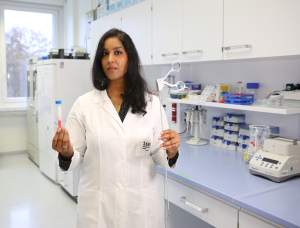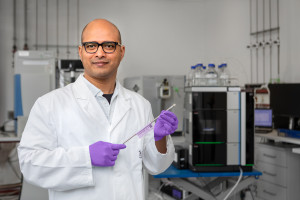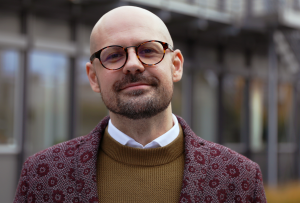Dortmund, 8th December 2021
Stabbing pain, chronic inflammation or infertility – these are only a few examples for the damage endometriosis can cause. It is an insidious chronic disease where growths from the lining of the uterus settle, for example, on the bladder or bowel. Endometriosis is so insidious because its symptoms are multifaceted and often ambiguous. That is why the path to a correct diagnosis is frequently arduous. According to the World Health Organisation (WHO), about 190 million women worldwide suffer from endometriosis; their diagnosis can take up to ten years. This is quite a long time, which results in more than a loss of quality of life. It also means a loss of valuable time for women who want to have children. Dr Brenda Krishnacoumar wants to change this. At ISAS’ first Postdoc Pitch Day, she presented a research idea that aims at giving women who suffer from the incurable disease more time.

Dr Brenda Krishnacoumar wants to replace the laparoscope, an instrument for conducting an abdominal endoscopy, with a blood test.
© ISAS
“Even though ten to 15 percent of women of child-bearing age in Germany suffer from endometriosis, very little research on the mechanisms of the disease exists. Endometriosis remains undetected for a long time, because its symptoms vary,” says the 31-year-old. Krishnacoumar wants to reduce the psychological stress and the additional burden caused by the uncertainty. A non-invasive method for the early detection of endometriosis does not yet exist. “This is where I want to start with my research and develop an early testing method,” the biologist explains. She plans to search for markers that make it possible to screen for endometriosis screening at a young age.
Early testing aims at improving quality of life & making family planning easier
Often, endometriosis has already caused irreparable damage at the time of diagnosis. For example, the ovaries can become clogged, endometriosis cysts can limit the ovaries’ function or endometrial lesions in the pelvis can reduce fertility. According to the Charité – Universitätsmedizin Berlin, 30 to 50 percent of women with endometriosis suffer from infertility. Although fertility improves for some after the displaced tissue is surgically removed, a number of women are unable to get pregnant even after fertility treatment.
For some of the affected a prematurely induced menopause has proven helpful. However, Krishnacoumar thinks that this is not an ideal solution: “Even if the symptoms improve, a hormonal menopause is still stressful for family planning.” Apart from that, neither surgery nor hormone therapy are a cure-all; endometriosis can return.
„We need gender equal science“
Krishnacoumar laments that there is a lack of information and research concerning endometriosis. According to her, one should not put up with diseases like endometriosis being dismissed. Although the disease is not deadly, it is still associated with a severe physical and psychological decline. “For gender equal science, we need more research for women,” the biologist demands.
The stage is set for new ideas at the first Postdoc Pitch Day
Krishnacoumar had been a postdoc at ISAS since September 2021. For the biologist it is very important to be able to pursue her own research questions. That is why she has been working on her research idea of an early testing method for endometriosis for the last few months. “The Postdoc Pitch Day was an excellent opportunity to figure out whether my idea has potential,” Krishnacoumar reports. She was one of the young researchers that presented their ideas in front of a panel of mentors, consisting of five working group leaders from different fields. After a five-minute pitch and a subsequent round of questions and discussion, the postdocs received feedback. Together, presenters and mentors also talked about opportunities for cooperation inside and outside the institute. According to Krishnacoumar, the different perspectives and opinions were very helpful for looking at her idea from various angles. “Now, I have specific aspects I can work on in order to then apply for project funding,” the researcher sums up.
Laparoscope from the 3D printer
In order to provide more insight into the situation of the afflicted, the postdoc came up with something special. With the help of one of ISAS’ 3D printers and simple tools from the hardware store, she recreated a laparoscope (see photo). The mentors were probably just as surprised as Krishnacoumar when they learned that a laparoscopic surgery is still the gold standard for diagnosing endometriosis.
Krishnacoumar wishes for the topic endometriosis to become more present, not only in medical training and research, but also in the general public: “It is not always about publishing papers that only the expert community will read. We should reach the people,” she says. That is exactly what she wants to contribute to with her research idea of early testing.
(Cheyenne Peters)








